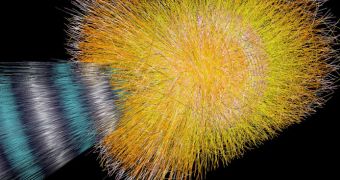Officials at the European Organization for Nuclear Research (CERN) announce that the Large Hadron Collider (LHC), the most powerful particle accelerator in the world, has just finished its mission of colliding protons head-on at high energy levels.
This was the first record-setting run that the facility conducted since being opened for science following a September 2008 incident that affected its superconducting magnets.
With the high-energy proton collisions ended today, November 4, engineering teams are scheduled to begin work on preparing the accelerator for its next mission, which will be to start colliding lead ions.
These collisions will take place at unprecedented energy levels, which only the LHC can reach. This phase of experimentation will last for about a month, officials the Organization say.
“Over the last seven months, the intensity of the LHC’s proton beams has increased 200,000 times, and the scientists from the LHC experiments have quickly converted proton collisions into scientific results,”explains Dennis Kovar.
“This is excellent progress for the brand-new accelerator and detectors, and bodes well for discoveries in the years to come,” adds the official, who is the US Department of Energy (DOE) associate director of Science for High Energy Physics.
During the lead ions collisions, the main experiments on the accelerator will have to keep track of as much as 10,000 particles each time ions collide.
The main goal of ion studies is to gain additional insight into the nature of quark gluon plasma (QGP), a state of matter that is believed to have permeated the Universe fractions of a second after the Big Bang exploded everything into being.
“The LHC’s lead-ion collisions may generate temperatures up to 500,000 times hotter than the center of the Sun,” adds Timothy Hallman, who is also a DOE associate director.
“The LHC experiments’ investigations into how the quark gluon plasma behaves at such temperatures will provide vital insight into why and how quarks and gluons cool from such high temperatures to bind together to form more complex particles and thus how our universe evolved into the form it has today,” he adds.
In addition to a large number of elementary particles that are already known and studied, the researchers are also hoping to find signs of new, exotic particles, that have eluded characterization until now.
Though the LHC is in Europe, the United States played an important role in constructing the accelerator and its four main particle detectors.
Statistics show that 1,700 scientists, engineers, students and technicians worked on this. These people come from 89 universities, seven DOE national laboratories, and one supercomputing center.

 14 DAY TRIAL //
14 DAY TRIAL //